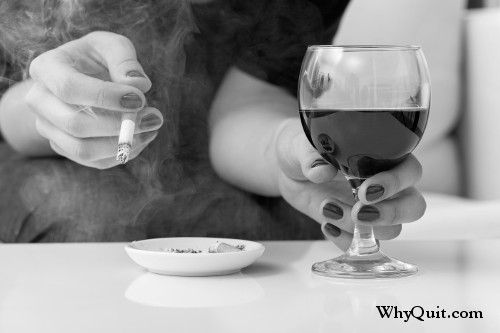 A 1990 study found that nearly half who relapsed to smoking (47%) consumed alcohol before doing so. It also found that another 5% had been under the influence of "recreational" drugs.[1]
A 1990 study found that nearly half who relapsed to smoking (47%) consumed alcohol before doing so. It also found that another 5% had been under the influence of "recreational" drugs.[1]
Early alcohol use is clearly the most avoidable relapse risk of all. Using an inhibition diminishing substance while in the midst of early physical withdrawal is inviting relapse.
How risky? A 2016 study found recent alcohol use during the first 21 days of recovery made smoking nearly 4 times as likely.[2]
Ex-users may feel alcohol effects sooner
There are a number of nicotine/alcohol interactions. Most obvious is the combined effects (or synergy) of both alcohol and nicotine stimulating the user's brain dopamine pathways and satisfying wanting for more.[3]
Additionally, as explained in Chapter 4, as with stress, alcohol use causes urine acidification, which in turn causes the user's kidneys to accelerate removal of the alkaloid nicotine from their bloodstream.
A third interaction may leave the user feeling intoxicated sooner. Nicotine stimulates the body's central nervous system while alcohol depresses it. Alcohol stimulates GABA production (gamma-aminobutyric acid), which produces a sedating effect[4] while impairing muscle (motor) control.[5]
Nicotine stimulates fight or flight pathways, causing the release of adrenaline and noradrenaline.[6] This is why alcohol-induced feelings of becoming sedated or even sleepy can be diminished by stimulating the body with nicotine.[7] Here's what to expect.
When drinking, the user soon begins noticing alcohol's gradual sedation and anesthesia type effects. The more they drink, the more sedated their nervous system becomes. The more they drink, the more acidic their urine becomes and the quicker their kidneys eliminate nicotine from their bloodstream.
Not only are they starting to feel tipsy, their nicotine reserves are declining faster than normal.
But just one powerful hit of nicotine and, in addition to an alcohol-exaggerated "aaah" wanting relief sensation, nicotine kicks in their automatic in-born "fight or flight" neuro-chemical response. The mind has been fooled into believing that danger is present and begins to stimulate an alcohol-sedated body.
Adrenaline, noradrenaline, and cortisol are released into the bloodstream. Their heart pounds faster and their rate of breathing increases. Digestion is suspended so that extra blood can be diverted to their muscles. Their pupils dilate, focus improves, hearing perks, and stored fats and sugars are pumped into their bloodstream, providing an instant source of energy.
An alcohol-depressed nervous system has just experienced some degree of stimulation. No saber tooth tiger to fight or flee, their newfound sense of alertness instead emboldens them to ask for another round. "Bartender, I'm ready for another drink!"
The cycle can be repeated again and again, with an increasingly sedated body gradually becoming less responsive to nicotine-induced stimulation.
What significance does this have to a recovering addict? It may mean that without nicotine periodically slapping you awake, that you may feel alcohol's effects sooner or after fewer drinks.
The solution can be as simple as learning to drink a bit more slowly, spacing drinks a bit further apart, or simply drinking less.
References:
2. Bold KW et al, Independent and interactive effects of real-time risk factors on later temptations and lapses among smokers trying to quit, Drug and Alcohol Dependence, Jan. 2016, Volume 158, Pages30-37.
3. Tizabi Y, et al, Combined effects of systemic alcohol and nicotine on dopamine release in the nucleus accumbens shell, Alcohol and Alcoholism, Sept-Oct. 2007, Volume 42(5), Page 413-416.
4. Koob GF, A role for GABA mechanisms in the motivational effects of alcohol, Biochemical Pharmacology, October 2004, Volume 68(8), Pages 1515-1525.
5. Hanchar HJ, et al, Alcohol-induced motor impairment caused by increased extrasynaptic GABA(A) receptor activity, Nature Neuroscience, March 2005, Volume 8(3), Pages 339-345.
6. Kenneth J. Kellar, KJ, Addicted to Nicotine, Neuropharmacology and Biology of Neuronal Nicotinic Receptors, National Institute on Drug Abuse website, www.DrugAbuse.gov, article updated May 19, 2006.
7. McKee SA, Effect of transdermal nicotine replacement on alcohol responses and alcohol self-administration, Psychopharmacology (Berlin), February 2008, Volume 196(2), Pages 189-200.
All rights reserved
Published in the USA
